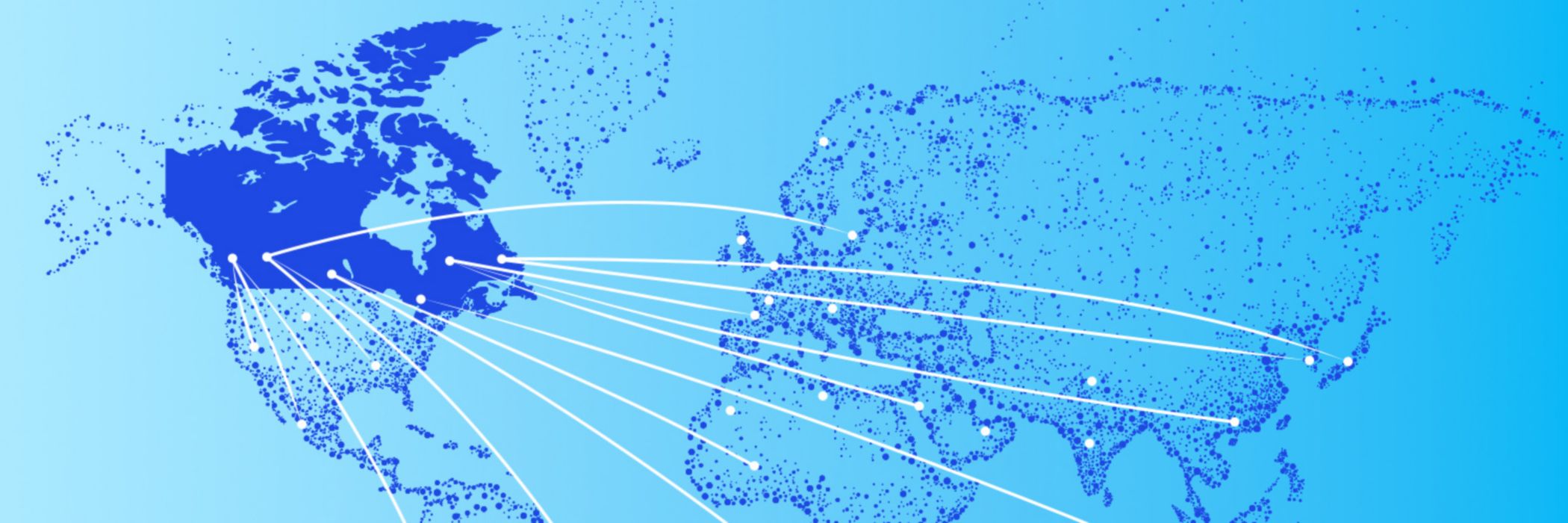Building resilience in the face of trade disruption
The recent trade landscape has been significantly impacted by tariffs between the U.S. and Canada, impacting over 80% of businesses. Tariffs, which are taxes imposed on imported goods, serve various purposes, including protecting local industries and influencing trade balances. They can encourage consumers to buy domestic products by making imports more expensive, but they may also lead to higher prices for consumers and provoke retaliatory measures from other countries, resulting in trade disputes.
РжгуЃЈLeyuЃЉЬхг§ЙйЭј is committed to supporting the Canadian business community during this period of uncertainty. By proactively strengthening resilience and adapting to the changing environment, Canadian businesses can foster growth and stability in the face of disruption.
80% of business leaders say they will be impacted by U.S. tariffs
Latest developments
- April 3, 2025: U.S. 25% tariffs on all foreign made cars and light trucks are now in effect. In response, Canada imposes a 25% tariff on all vehicles imported from the U.S. that are not compliant with the Canada-U.S.-Mexico trade agreement (CUSMA), with the exception of auto parts.
- April 2, 2025: U.S. announces a series of global reciprocal tariffs, with the notable exception of goods compliant under the Canada-U.S.-Mexico trade agreement (CUSMA). Goods that are not CUSMA compliant are subject to a 25% tariff, with the exception of energy products and potash which are subject to a 10% tariff.
- March 12, 2025: U.S. 25% tariffs on steel and aluminum are now in effect. In response, Canada has implemented retaliatory 25% tariffs on $29.8 billion worth of US made goods.
- March 4, 2025: U.S. tariffs imposing a 25% levy on Canadian goods introduced. In response, Canada imposes a 25% tariff on $30 billion worth of American goods. The provincial governments have also implemented other non-tariff countermeasures.
Subscribe now to receive research, insights and event notifications straight to your inbox
Fostering a stronger, more resilient country
The uncertainty around U.S. trade policy has had Canadian companies rushing to find ways to mitigate their risk and tariff-proof their organization. While it varies by company and industry, mitigation strategies include identifying areas to optimize and streamline operations, forming partnerships to open up new markets, diversifying supply chains, divesting non-core activities, exploring foreign-exchange hedging opportunities, incorporating tariff and transfer pricing plans, seeking exemptions, and securing subsidies or taking advantage of tax incentives.
We interviewed 602 Canadian business leaders to understand their reactions and responses to the tariff threats posed by U.S. President Donald Trump. Our research finds that most leaders want the federal and provincial governments to take immediate steps to eliminate inter-provincial trade barriers, reform the tax system, provide incentives to onshore and encourage Canadians to тBuy Canadian.т� 1
76% are undertaking a strategic review of their operations due to the trade uncertainty
84% say the elimination of interprovincial trade barriers will be тextremely or veryт� important to the survival of their business in a trade war with the U.S.
31% say they could redirect 11-to-25 per cent of their sales to markets in Canada
- 67 per cent say a weak Canadian dollar will partially or fully offset the negative impact of tariffs, 10 per cent say it will put them in a net positive position, 17 per cent it would not help them, and 6 per cent are unsure
- 78 per cent say they need to build resiliency into their supply chains (e.g., alternative sources, implementing technology to predict disruptions, optimize logistics, etc.)
- 86 per cent want Canada to move an increased volume of oil and gas (West to East pipelines) to reduce reliance on moving oil and gas from the U.S. to Eastern Canada
Implementing a proactive trade strategy
In the current environment, it is highly important to proactively assess current business strategies, structures and supply chains to mitigate risk and build resiliency.
Utilize trade data to gain a comprehensive understanding of the current landscape, including potential impacts and opportunities. This information can help pinpoint specific products or materials that are most susceptible to tariff increases and assess their effects on revenues, operations, and partnerships. By grasping the potential impact of tariffs on costs, companies can adopt cost-saving measures to sustain profitability.
Prioritize targeted operating outcomes to develop a response strategy model and scenario evaluation:
Diversify supply chains: By improving supply chain visibility, companies can better understand their operations and consider alternative suppliers located in countries with fewer tariffs, which can help reduce the risks of disruption. Additionally, enhancing resiliency through scenario planning and data-driven decision-making will enable proactive planning for future challenges.
Tariff exclusion process: Some tariffs allow for exclusions that fit the eligibility criteria. Companies can request exclusions for specific products, requiring detailed justifications and documentation.
Strategic transfer pricing: Transfer pricing plays a significant role in customs valuation, as it can directly impact the amount of tariffs paid. By establishing a lower transfer price, businesses may be able to reduce their tariff liabilities.
Evaluate contracts and partnerships: Conducting a thorough review of contracts related to customs duties and tariffs to understand obligations between parties can provide opportunities for cost reduction and improved compliance.
Country-of-origin rules: Assess the application of these rules in your operations.
The Canadian government introduced the tariff remission process as support for businesses impacted by tariffs. Collect the necessary information and submit an application for tariff recovery on goods imported from the U.S. for qualifying entities under the Canadian tariff remission process. These entities can recover tariffs if the goods cannot be sourced from Canada.
Access to insightful trade intelligence will be critical for businesses to stay informed and allow them to proactively adjust their strategies and operations. This monitoring will help minimize unexpected costs and disruptions, ensure compliance, and maintain competitive advantage in the global market. РжгуЃЈLeyuЃЉЬхг§ЙйЭј professionals can support with ongoing monitoring and guide you on how changes could impact your company.
A comprehensive approach to your trade strategy
РжгуЃЈLeyuЃЉЬхг§ЙйЭј Tax, Legal and Advisory leaders can help provide comprehensive support on tariffs and key considerations for navigating the path ahead.
Optimize supply chains, mitigate impact and recover applicable tariffs
Assess structures and policies to reduce tariff liabilities
Enhance resiliency to enable business continuity
Evaluate and manage enterprise risks and compliance obligations
Evaluate contracts and partnerships to understand obligations
Optimize capital and strategic restructuring to endure challenges
Manage productivity, risk, and change in the short through long term
Have a question for our team of professionals?
As Canada pulls together to address these uncertain times, РжгуЃЈLeyuЃЉЬхг§ЙйЭј teams can help equip you with the insights you need to make informed decisions on whatтs best for your business. Contact us today.
Events
Watch
Mar 26, 2025 | РжгуЃЈLeyuЃЉЬхг§ЙйЭј International
Watch
Feb 25, 2025 | РжгуЃЈLeyuЃЉЬхг§ЙйЭј in Canada
Watch
Feb 12, 2025 | РжгуЃЈLeyuЃЉЬхг§ЙйЭј International
Watch
Navigating the new administrationтs key trade policies
Feb 6, 2025 | РжгуЃЈLeyuЃЉЬхг§ЙйЭј U.S. webcast
Watch
Feb 5, 2025 | РжгуЃЈLeyuЃЉЬхг§ЙйЭј in Canada
Watch
Inbound distribution in the US in 2025: The year of tariffs and Amount B
Feb 4, 2025 | РжгуЃЈLeyuЃЉЬхг§ЙйЭј U.S. webcast
Watch
Jan 28, 2025 | РжгуЃЈLeyuЃЉЬхг§ЙйЭј in Canada
Insights and resources
Connect with us
About the РжгуЃЈLeyuЃЉЬхг§ЙйЭј in Canada Tariffs Survey
РжгуЃЈLeyuЃЉЬхг§ЙйЭј in Canada surveyed 602 Canadian business leaders between February 13 and February 28 on Sago's premier business panel, using Methodify's online research platform. Eighty-nine per cent export to the U.S. and 80 per cent said they will be impacted by U.S. tariffs. Annual revenue breakdown: 26 per cent, between $500 million and $1 billion, 26 per cent, between $100 million and $500 million, 19 per cent, between $50 million and $100 million, 16 per cent, between $10 million and $50 million, and 13 per cent, more than $1 billion. No companies under $10 million in annual revenue were surveyed.








